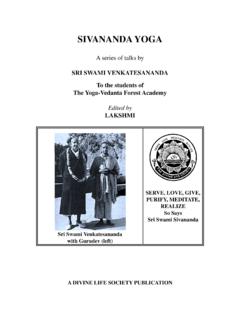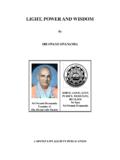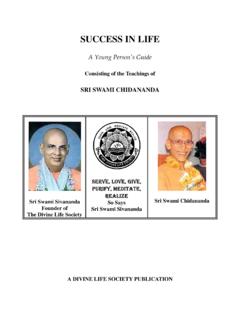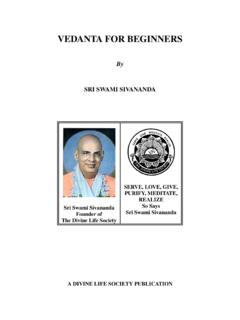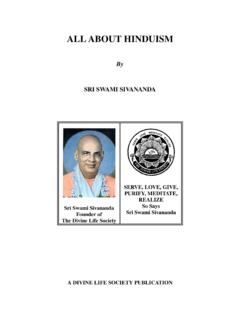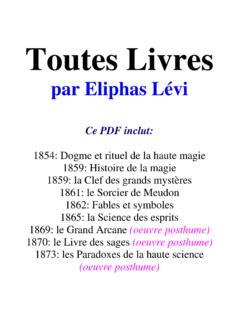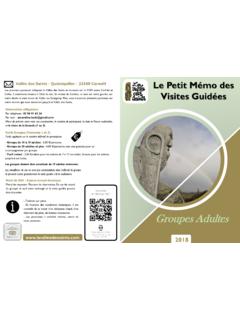Transcription of Practical Lessons In Yoga
1 Practical Lessons . IN. yoga . By SRI SWAMI SIVANANDA. SERVE, LOVE, GIVE, PURIFY, MEDITATE, REALIZE. Sri Swami Sivananda So Says Founder of Sri Swami Sivananda The Divine Life Society A DIVINE LIFE SOCIETY PUBLICATION. Eighth Edition: 1997. (Copies 6,000). World Wide Web (WWW) Edition: 2001. WWW site: This WWW reprint is for free distribution The Divine Life Trust Society ISBN 81-7052-010-X. Published By THE DIVINE LIFE SOCIETY. SHIVANANDANAGAR 249 192. Distt. Tehri-Garhwal, Uttaranchal, Himalayas, India. TO. STUDENTS OF yoga . IN. THE EAST AND THE WEST. PUBLISHERS' NOTE. His Holiness Sri Swami Sivananda Saraswati is, as it were, an ornament of not only the glorious Himalayas and India but of the entire world.
2 From the cool heights of his Himalayan Ashram, Ananda Kutir, the great Yogi stood as a mighty dynamo radiating Divine Love, Joy and Peace to millions upon millions of bleeding hearts all over the world, a Yogi, who shines as a brilliant pole-star in the spiritual firmament of the universe, guiding the tired and restless traveller towards the haven of Peace, Bliss and Knowledge. As a great saint and philosopher, his spotless purity, saintliness of life, magnetic and voluminous writings were unparalleled in record; he was not only an eminent and popular author of Hindu religious and philosophical subjects, but is an authority on those subjects. He was not only a man of letters and vast erudition, but also one who had in a full measure realised the incalculable benefits of Yogic practices in the course of a strenuous struggle of over fifteen years of intense dispassion and rigorous austerities in the holy regions of the Himalayas.
3 Moreover, his priceless writings through the medium of some of the well-known and influential newspapers, magazines and journals not only in India but also abroad and in America coupled with his own unique and powerful personality and realisation have won for him an enviable place of honour in every spiritually, religiously and philosophically inclined home in India. In fact, if the political India of the present day can be proud of at least one Gandhi, the spiritual India can be reasonably proud of at least one Sivananda! The object with which this book is published is twofold. Year in and year out large numbers of Europeans and Americans, men and women, came out to India to learn yoga under an Adept and practice the same in India itself.
4 In the course of their endless wanderings and searches for such Adepts in yoga , these people had no other alternative but to resort to the Himalayan Ashram of Swami Sivananda. But unfortunately owing to several causes these travellers could not remain long in this country. They went back home learning something here and something there, in bits, but nothing from one Yogi only, which alone could be said to be of some solid and Practical utility to them. The Westerners, interested in Yogic practices, had naturally to take resort to books and other literature on the subject, which were either unintelligible to them or, as was more often than not, had been written by persons whose aim in writing books was, in ninety-nine cases out of every hundred, to show off their learning rather than to teach yoga and make the subject intelligible and interesting to the public.
5 This is the difference between books written by most writers and those by Swami Sivananda. Moreover, unlike several others, Swami Sivananda Saraswati was a Practical Yogi, who fully realised the fruits of yoga and was therefore best suited to write books on the subject from his own Practical experience. The present book has been specially designed by the author keeping in mind the needs of the students of yoga in Europe and America, who need a Practical but non-technical presentation of the subject in a language which is accessible to the beginner in the path. We hope the book will amply serve this most sacred purpose in view. iv May the unfailing blessings of Swami Sivananda pour forth in profusion over the heads of all the readers in the West and East, nay, North and South, and lead them on to Satchidananda which every one is seeking at heart!
6 THE DIVINE LIFE SOCIETY. PREFACE. This book entitled Practical Lessons in yoga consists of twelve easy and interesting Lessons . The First lesson deals with yoga and Its Objects. The Second lesson treats of yoga Sadhana or the practice of yoga and contains a clear and lucid description of the four important paths viz., Karma yoga , Bhakti yoga , Raja yoga and Jnana yoga . One can easily choose for himself a path according to his particular taste, temperament and capacity by a close study of this lesson . I firmly hold that no one wishing to become a perfect Yogi can realise his wish, if he does not begin his Yogic practices with Karma yoga or doing actions for actions' sake, without the idea of agency and without expectation of the fruits of his actions.
7 I have also made passing references to the various other forms of yoga such as Hatha yoga , Mantra yoga and Kundalini yoga . In the Third lesson on Yogic Discipline I have clearly and expressly stated that the practice of yoga is rooted in the cultivation of virtues and the eradication of negative qualities, and have also stated in detail what virtues should of necessity be cultivated and what vices are to be eradicated, and through what means. Yogic Diet forms the subject-matter of the Fourth lesson . It should be distinctly borne in mind that mind is made up of the fine particles of food that we take, and we are what we eat. If the student of yoga who is a neophyte desires to lay a firm, sure and sound foundation in his practices, he should take care to eat only such foods that are conducive to his spiritual advancement and progress, and avoid all others.
8 A list of the various articles of diet, prescribed and prohibited, is also given. In the Fifth lesson I have taken all care to collect the various stumbling blocks in the way of the aspirant and the various means of overcoming them. I strongly advise the student to read and re-read this lesson a number of times in order that he may be cautious in moments of temptation. Then in the Sixth lesson I have dealt with Yogasanas or Yogic postures. It is very necessary for the would-be Yogi to maintain a sound and vigorous body and mind to achieve success in his undertaking, and in order that he might achieve this end, a number of simple and easy exercises, physical and consequently mental, have been prescribed.
9 These exercises were practiced by Yogins and Rishis of yore and are still being practiced in India and other countries with astonishing results. The Seventh lesson treats of Pranayama or regulation of breath. Simple and Practical exercises have been prescribed for the regulation and control of breath. which will ultimately result in the control of the mind. These exercises in breath-control are not merely for enhancing the soundness and control of the mind, but they also play a vital part in ensuring a sound body. The student of Pranayama who attains perfection in it will have various psychic powers. v Regulation of breath and control of mind lead to concentration. So concentration is the topic of the next lesson .
10 I have dealt at length with the nature of the mind and the methods through which it can he controlled. Some Practical exercises are given to attain success in concentration. The Ninth lesson deals with Meditation because the fruit of concentration is meditation. A. number of easy and interesting exercises have been described. The fruit of meditation is Samadhi and this forms the subject-matter of the next lesson . Samadhi is superconscious state, wherein the Yogi gets superintuitional or supersensual knowledge and supersensual bliss. In Samadhi the Yogi communes with the Lord and enjoys Absolute Independence. He has reached the Goal now. In the Eleventh lesson I have dealt with the Serpentine Power or the mighty pristine Force underlying all organic and inorganic matter.
